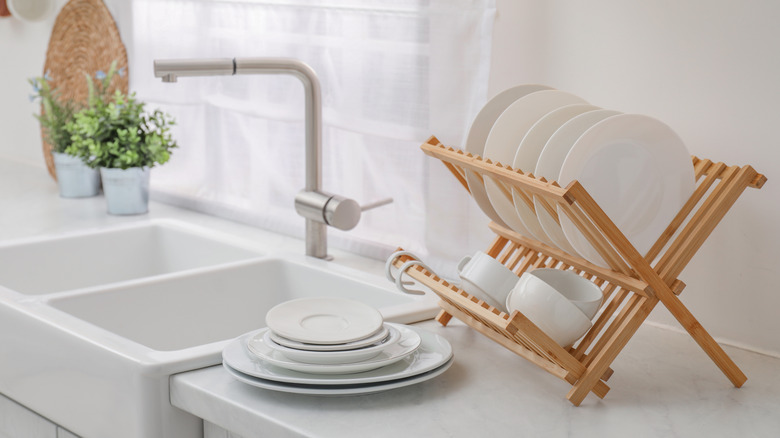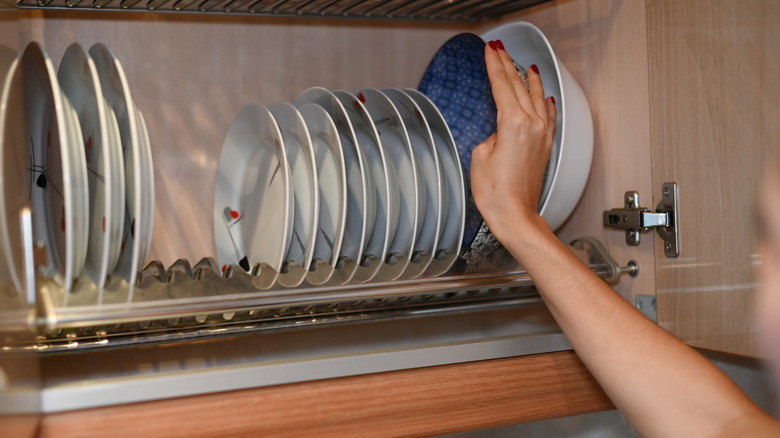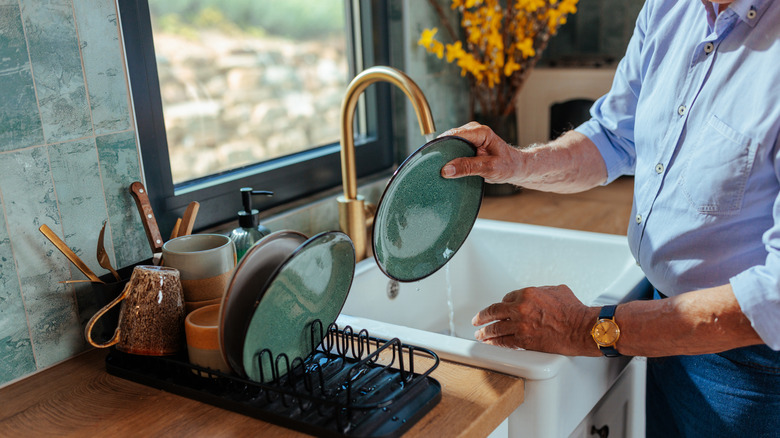Why Traditional Dish Racks Have Gone Out Of Style In Kitchens
Trends come and go, with some retro kitchen items making a stylish comeback, while others are better left in the past. One kitchen item that seems to have gone out of style is the traditional dish rack — the countertop stand designed to hold washed dishes, glasses, and utensils upright so that they can air-dry. They're undeniably useful, so what caused their decline in popularity? To find out, Food Republic consulted Bree Uebergang, co-founder and cleaning expert at Filthy Clean.
"They take up too much space and usually don't look great. Most people I work with want clear counters and clean lines, especially in smaller kitchens," Uebergang told us. There are several tricks to make a smaller kitchen feel larger, like choosing sliding doors instead of hinged ones, or opting for a peninsula over an island, but the easiest way to open up your space is by reducing visual clutter. A dish rack filled with plates and cutlery instantly draws attention and makes the space feel crowded and less organized.
Another reason the dish rack has fallen out of favor is that it's simply not as useful as it once was. "If there's a dishwasher, even a compact one, the old-school dish rack often gets shoved under the sink or tossed entirely," Uebergang told us. Today, dishwashers are extremely common in most kitchens. They've automated the dishwashing and drying process, making the dish rack largely obsolete. "People just don't want something that bulky sitting out unless they use it every day," Uebergang explained.
Modern kitchen designs strive to conceal dish drying
These days, there's no shortage of kitchen-design trends to choose from. Country-style kitchens are making a nostalgic comeback, cottage-core is all the rage, and minimalist kitchens, which emphasize sleek, intentional functionality, clean designs, and most importantly, no clutter, are enticing to many. According to Bree Uebergang, "We're seeing more integrated setups that make drying less visible. Things like slotted trays that drain into the sink ... or drying grooves built into the countertop." Hidden pull-out drying drawers and dish cabinets with built-in drop trays also fall into these categories, blending convenience with clean design to reduce visual clutter. This renders dish racks outdated eyesores.
For those who still prefer the practicality of air-drying dishes without sacrificing space or disrupting the kitchen's visual flow, Uebergang recommends roll-up racks. "They disappear when you're done and don't eat into your prep space," she told us. These racks also eliminate the problem of water dripping onto counters as dishes dry. "Quick-dry mats are another option," she added. These can come in a variety of materials, including natural ones like stone, providing flexibility while contributing to a minimalist finish.
When can dish racks can still be practical?
While the traditional dish rack may no longer be as in vogue as it once was, there are still plenty of situations where having one is practical, and in some cases even preferred. As Bree Uebergang notes, people who are constantly hand-washing items such as "sharp knives, baby bottles, or nonstick pans" often rely on dish racks. There are many reasons why the dishwasher can't always get the job done. Sometimes it's simply too full, or items may not be dishwasher safe, like a wooden cutting board that risks warping. Other times, delicate glassware or ceramics might be too fragile for an intense cycle, which can also cause high-quality knives to quickly become dull. No matter how streamlined your kitchen setup is and how hard you try to avoid it, some hand-washing is always going to be necessary.
"I've seen clients try to get rid of them for the aesthetic, but the dishes just pile up on a towel instead," Uebergang explains. "A small, smartly designed rack still has a place if it fits your routine." The key here is choosing a dish rack that complements your kitchen's aesthetic instead of clashing with it. For minimalist spaces, this means looking for racks in neutral shades like white, black, or gray, paired with clean lines that blend seamlessly into the countertop. Foldable or collapsible models are also excellent choices, as they can be tucked away into a cabinet when not in use, preserving the overall vibe of your kitchen space.



